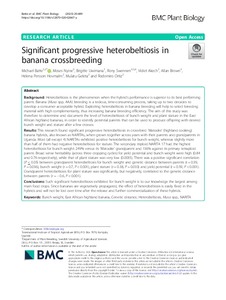| dc.contributor.author | Batte, M. |
| dc.contributor.author | Nyine, M. |
| dc.contributor.author | Uwimana, B. |
| dc.contributor.author | Swennen, R. |
| dc.contributor.author | Akech, V. |
| dc.contributor.author | Brown, A. |
| dc.contributor.author | Hovmalm, H.P. |
| dc.contributor.author | Geleta, M. |
| dc.contributor.author | Ortiz, R. |
| dc.date.accessioned | 2021-07-08T08:33:49Z |
| dc.date.available | 2021-07-08T08:33:49Z |
| dc.date.issued | 2020 |
| dc.identifier.citation | Batte, M., Nyine, M., Uwimana, B., Swennen, R., Akech, V., Brown, A., ... & Ortiz, R. (2020). Significant progressive heterobeltiosis in banana crossbreeding. BMC Plant Biology, 20(1), 1-12. |
| dc.identifier.issn | 1471-2229 |
| dc.identifier.uri | https://hdl.handle.net/20.500.12478/7163 |
| dc.description.abstract | Background Heterobeltiosis is the phenomenon when the hybrid’s performance is superior to its best performing parent. Banana (Musa spp. AAA) breeding is a tedious, time-consuming process, taking up to two decades to develop a consumer acceptable hybrid. Exploiting heterobeltiosis in banana breeding will help to select breeding material with high complementarity, thus increasing banana breeding efficiency. The aim of this study was therefore to determine and document the level of heterobeltiosis of bunch weight and plant stature in the East African highland bananas, in order to identify potential parents that can be used to produce offspring with desired bunch weight and stature after a few crosses. Results This research found significant progressive heterobeltiosis in cross-bred ‘Matooke’ (highland cooking) banana hybrids, also known as NARITAs, when grown together across years with their parents and grandparents in Uganda. Most (all except 4) NARITAs exhibited positive heterobeltiosis for bunch weight, whereas slightly more than half of them had negative heterobeltiosis for stature. The secondary triploid NARITA 17 had the highest heterobeltiosis for bunch weight: 249% versus its ‘Matooke’ grandparent and 136% against its primary tetraploid parent. Broad sense heritability (across three cropping cycles) for yield potential and bunch weight were high (0.84 and 0.76 respectively), while that of plant stature was very low (0.0035). There was a positive significant correlation (P < 0.05) between grandparent heterobeltiosis for bunch weight and genetic distance between parents (r = 0.39, P = 0.036), bunch weight (r = 0.7, P < 0.001), plant stature (r = 0.38, P = 0.033) and yield potential (r = 0.59, P < 0.001). Grandparent heterobeltiosis for plant stature was significantly, but negatively, correlated to the genetic distance between parents (r = − 0.6, P < 0.001). Conclusions Such significant heterobeltiosis exhibited for bunch weight is to our knowledge the largest among main food crops. Since bananas are vegetatively propagated, the effect of heterobeltiosis is easily fixed in the hybrids and will not be lost over time after the release and further commercialization of these hybrids. |
| dc.description.sponsorship | International Institute of Tropical Agriculture |
| dc.description.sponsorship | Bill & Melinda Gates Foundation |
| dc.format.extent | 1-12 |
| dc.language.iso | en |
| dc.subject | Bananas |
| dc.subject | East Africa |
| dc.subject | Genetics |
| dc.subject | Musa |
| dc.title | Significant progressive heterobeltiosis in banana crossbreeding |
| dc.type | Journal Article |
| cg.contributor.crp | Roots, Tubers and Bananas |
| cg.contributor.affiliation | International Institute of Tropical Agriculture |
| cg.contributor.affiliation | Kansas State University |
| cg.contributor.affiliation | Swedish University of Agricultural Sciences |
| cg.coverage.region | Africa |
| cg.coverage.region | East Africa |
| cg.coverage.country | Uganda |
| cg.coverage.hub | Eastern Africa Hub |
| cg.researchtheme | Biotech and Plant Breeding |
| cg.identifier.bibtexciteid | BATTE:2020 |
| cg.isijournal | ISI Journal |
| cg.authorship.types | CGIAR and advanced research institute |
| cg.iitasubject | Agronomy |
| cg.iitasubject | Banana |
| cg.iitasubject | Plant Breeding |
| cg.iitasubject | Plant Production |
| cg.journal | BMC Plant Biology |
| cg.notes | Open Access Journal; Published online: 27 Oct 2020 |
| cg.accessibilitystatus | Open Access |
| cg.reviewstatus | Peer Review |
| cg.usagerightslicense | Creative Commons Attribution 4.0 (CC BY 0.0) |
| cg.targetaudience | Scientists |
| cg.identifier.doi | https://dx.doi.org/10.1186/s12870-020-02667-y |
| cg.iitaauthor.identifier | Michael Batte: 0000-0002-6793-2967 |
| cg.iitaauthor.identifier | Moses Nyine: 0000-0002-8409-7588 |
| cg.iitaauthor.identifier | Brigitte Uwimana: 0000-0001-7460-9001 |
| cg.iitaauthor.identifier | Rony Swennen: 0000-0002-5258-9043 |
| cg.iitaauthor.identifier | Allen Brown: 0000-0002-4468-5932 |
| cg.futureupdate.required | No |
| cg.identifier.issue | 1 |
| cg.identifier.volume | 20 |

